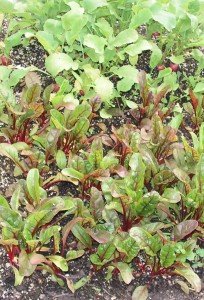 The Joys of Seed Catalogs and Baby Veggie Starts
The Joys of Seed Catalogs and Baby Veggie Starts
Deciding what to plant in the vegetable garden can be exhilarating as it means we get to pour over seed catalogs, browse through young vegetable starts at the local nursery or farmer’s market or pull out our colored pens and draw intricate maps and charts of our proposed garden plot.
Deciding What to Grow When You’re a New Gardener
It can also be daunting if you are a new gardener and really don’t know what to expect, which plants go well together in the garden or how much of which plants to grow.
There are several different approaches you can take as you work out which vegetables you want to plant.
Choose What You Love
First, of course, you ought to consider what you like most to eat, what your family likes to eat, and what you know you really want to enjoy as fresh homegrown produce.
Tomatoes and Corn – Two Top Favorites
For many people at the top of that list are tomatoes, but if you are sensitive to the nightshade family, this may not be you. For others, there is nothing like sweet corn and despite its need for quite a large growing space, many home gardeners insist on it (as we do!). Besides, if you grow corn, it is an easy excuse to grow winter squashes, pumpkins, or melons, as these grow well interplanted with the corn and then to add pole beans and plant a “three sisters garden”.
However, if this is your first garden, you may not have room for these three companion vegetables unless you give up everyone else in the garden, as they will take up a ten by ten foot block without even blinking, and if you plant less than a ten foot square of corn you are unlikely to get good yield as they need to cross pollinate in order to form the corn ears. So, think carefully before making the commitment to corn, as it is a large commitment in a home garden space.
One way to consider the decision is to know whether or not you can get local organic corn where you live, because it is now estimated that over 95% of commercially grown corn is genetically modified and if you are growing the garden in part to avoid GMO’s then corn is a biggie.
Choosing What’s Easiest to Grow
Another approach to garden vegetable selection is to focus and select plants based on their ease of growing. This is a good choice for several reasons, so long as it also conforms to vegetables you like to eat. There really is no point growing something you or your family won’t eat!
One reason it’s good to start with simple and easy is that early success will give you confidence and pleasure. Another is that by building on successes and starting simple you will add to your skills incrementally and before you know it you will have a solid successful gardening experience stretching over years.
Simple Salad Gardens
Depending on the space you have available you may also simply want to grow a kitchen garden of greens and a few herbs and one or two tomatoes or dwarf squashes, peppers or eggplants and keep it simple.
Here’s a helpful list of the easiest to grow vegetables to get you started:
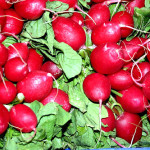 Radishes: These may be the easiest of all garden veggies to grow. They are a favorite for teaching children about gardening because they come up so fast and are ready to eat in only a few weeks after that.
Radishes: These may be the easiest of all garden veggies to grow. They are a favorite for teaching children about gardening because they come up so fast and are ready to eat in only a few weeks after that.
These days there are all kinds of radishes to choose from, particularly in the heirloom varieties.
Radishes are also a great garden ally for many other vegetables: they help beets, beans, carrots, cucumbers, lettuce, peas, spinach and squash and are often recommended to be planted in amongst these other vegetables.
As if that wasn’t enough, radishes are also a ‘marker’ vegetable for calcium in the garden soil. If your radishes are healthy and plump, you have good calcium supply in the garden. But, if they have woody, small, deformed roots instead of nice plump fleshy radishes for roots, you need to add calcium to your soil!
Finally, radishes bring up nutrients from deeper in the garden, specially the nice long ones like daikons. They actually mine minerals from down in the soil and bring them to the surface, so even if you do not like, or usually eat radishes, they are great to plant in the garden – just let them grow and go to seed – they will be improving the garden for all the vegetables you do want to eat.
Okay, so obviously, you’ll be growing radishes…
Beans: Bush or Pole. Beans are another vigorous grower and one of those plants often grown in the classroom for young children to learn about growing plants because they are very hardy and fast growing.
There are so many varieties to choose from that it’s conceivable one could grow an entire garden of just beans. Not that we recommend this, because you will never eat them all. They produce a LOT.
Choosing between bush or pole (runner) beans is more a matter of space than of variety these days as most beans come in both bush and pole types. A good crisp green bean is a delight and beans provide the added benefit of fixing nitrogen in the soil. They actually harvest nitrogen out of the air and fix it in the soil, which is one of the reasons they are so beneficial to corn, a heavy nitrogen feeder.
Beans like carrots, peas, cucumbers and radishes and get along fine with potatoes, brassicas (cabbages, kales, broccoli, Brussel sprouts, cauliflower and mustards), eggplant, beets, celery and even strawberries. They do not do well with the onion and garlic family.
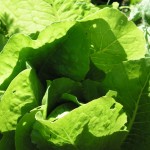 Lettuce: all types, but particularly loose leaf, simpsons, red leaf, boston, butter crunch. Or, start with a garden mix of lettuces available from most seed companies.
Lettuce: all types, but particularly loose leaf, simpsons, red leaf, boston, butter crunch. Or, start with a garden mix of lettuces available from most seed companies.
Lettuce can be planted in succession, a new set of seeds every other week to have fresh salad fixings all summer long. In hot weather they tend to bolt, so plant them in the shade of larger plants as you get further into the season. They don’t take up much space, just slip them in under a tomato plant or two.
Carrots: plenty of choices here as well, and you can choose stubby carrots if your garden is not well established with deep tilth, they do well with lettuce and radishes too.
Remember to thin them as they grow so they have room enough to get plump. If you time it right you get baby carrots as a reward for thinning.
Cucumbers: Cucumbers are great producers and like squash will give you great yield for your effort. Unlike summer squash, they are sprawlers (or climbers if you train them vertically) and produce lots of fruits all along their vines. They can be used as the vining plant in the three sisters garden for those who insist on growing their own corn.
Cucumbers also do very well with beans, peas, carrots, and, of course, those radishes. Actually the radishes are a big help with cukes as they deter the cucumber beetle. Planting cucumbers and pole beans with a bamboo trellis works very well and the plants do well together.
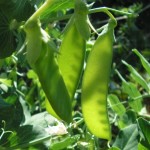 Peas: Peas are another of the great producers in a vegetable garden. The more you pick, the more they make. Self pollinating, peas are epic climbers and will send out their curling tendrils anywhere and everywhere to find something to grasp hold of and go. So give them a bamboo pole or some string between poles. They don’t need much but they need something.
Peas: Peas are another of the great producers in a vegetable garden. The more you pick, the more they make. Self pollinating, peas are epic climbers and will send out their curling tendrils anywhere and everywhere to find something to grasp hold of and go. So give them a bamboo pole or some string between poles. They don’t need much but they need something.
Those string mesh trellises work very well – the ones that have six inch to one foot squares of string in a three or four foot wide mesh. Draped above the peas from a nearby fence or post, they’ll give the peas all they need to create a wall of pea production in short order.
They are a cool weather plant, so if you have hot summers, plant them where they get morning sun and afternoon shade and they will go on producing all summer. Remember to keep picking the peas! We love both the snow and sugar-snap peas. Either one can be eaten pod-and-all when picked early. Tender, crunchy goodness in its own little package. Delicious! We don’t bother with any of the others, too starchy and dull for our tastes.
Peas like carrots, radishes, lettuces, aromatic herbs and tomatoes too. So they will fit in quite nicely with this little garden plot. Just don’t plant onions or garlic next to them, they don’t get along.
Oh, but speaking of tomatoes…
Tomatoes: Again, plenty to choose from, and everyone loves cherry tomatoes, which are wonderfully plentiful and often eaten on the spot as they ripen in the garden.
Tomatoes also do well with carrots and lettuces; although they may stunt carrots’ size, but the carrots will still taste great. If you do grow tomatoes, plant basil and parsley (regular curly/Italian not cilantro) in amongst the plants for increased vigor and production. Since your peas also like aromatic herbs, throw in a rosemary or two and a mint (so long as you can keep it from taking over the whole garden!) as these will make everyone happy. Or, if mint is too invasive, pick mint leaves from other areas outside the garden and use them as mulch around the peas and tomatoes.
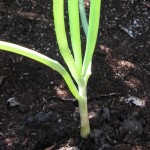 Onions: We like the green onions in the garden the best, but we also grow the large variety. Green onions are quick and easy though, and can go in around the lettuces, so long as you keep them away from the peas.
Onions: We like the green onions in the garden the best, but we also grow the large variety. Green onions are quick and easy though, and can go in around the lettuces, so long as you keep them away from the peas.
They are tasty and quick and as you thin them you get small scallions for the supper salad. Plant a lot of little bunches of them as they will want to come up out of the garden as a bunch when harvested and if you plant them too closely together you’ll have one massive bunch of scallions on your hands. (Guess how we found that out!)
Seed catalogs sometimes call them bunching onions, scallions or green onions… seems there is still a bit of variety in their names, but whatever you call them they are easy to grow and a real taste treat.
Another thing to know about onions, they are great pest deterrents. Plant them around perimeters of lettuces, carrots and other vegetables to keep the bugs and predators away.
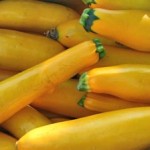 Squashes: While there are some gardeners who say they’ve ‘sworn off zucchini’ after years of having more than they could easily give away, never mind eating it morning, noon and night, the squashes are still a great family and easy to grow.
Squashes: While there are some gardeners who say they’ve ‘sworn off zucchini’ after years of having more than they could easily give away, never mind eating it morning, noon and night, the squashes are still a great family and easy to grow.
A straight neck or crookneck yellow squash is as easy to grow as zucchini, steamed with a little butter it is the closest thing to sweet corn that is not corn. In years when we did not grow corn for want of space, the yellow summer squash almost made it bearable…
These squash are NOT the ones to plant under your corn if you do grow corn, their leaves and stalks are too upright – they need their own space, and would knock down young corn plants.
On their own they do just fine, however, in good full sun, and get along with everyone else on our list here, although they should not be planted too close to tomatoes as they sprawl and can take up a very large space indeed. While lettuce, radishes, carrots and onions can grow down along and around the squash, the tomatoes will not be so willing to share their space. Do plant borage around them; actually, plant borage anywhere in the garden, it helps everyone and attracts all the good pollinators you’ll ever need. Oregano is also helpful for squashes. And don’t forget those radishes… Icicle radish are the recommended helper for summer squashes. (just sayin’).
So there’s your easy list of what to grow – or at least the easiest things TO grow. We would add sweet peppers to the list if it were true, but it’s not. Hot peppers are easier, so you might want to try a few of these first.
Sweet peppers can be finicky and often fail to fruit if they don’t get every little thing they need. But if you want to try them anyhow, plant them near the tomatoes and dig in a few handfuls of bone or blood meal at the start of the season under the spot they’ll go in to. That will be good for your tomatoes too.
Peppers also like onions, and get the same benefit as tomatoes from parsley and basil, so keep them in that group on the onion side of the party. They often benefit from side dressing of bone or blood meal, and some people swear by Epsom salts, especially just as they bloom to help the fruits set.
Now all you have to do is decide if you are going to go for that corn or not…
Resources:
Mother Earth News, Carrots Love Tomatoes – Companion Planting for a Healthy Garden: http://www.motherearthnews.com/organic-gardening/carrots-love-tomatoes-companion-planting-for-a-healthy-garden-zb0z11zbug.aspx


